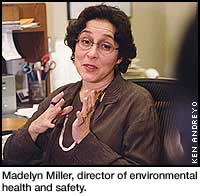|
|
||
|
|
|
University Adapts Emergency Protocols In Response to Incidents of Anthrax
Efforts have been made to notify members of the university community about appro-priate actions to take. EHS has published a Web site (http://www.cmu.edu/ehs/anthrax2.html) listing characteristics of a "suspicious" letter or package and what individuals should do and not do when receiving mail that looks suspicious.
Email was sent to faculty, staff and students publicizing the Web site and urging members of the community to contact University Police (8-2323) if they are concerned about a mail package, letter or substance.
EHS says suspicious-looking mail may be unexpected packages from someone unfamiliar to you. It may be addressed to someone who no longer works in your office or it may have an improper title or address for someone. The postmark may not match the return address or it may not even have a return address. The package may be marked "personal" or "confidential," be an unusual size or weight or have a strange odor or stains.
The EHS Web site states individuals should NOT open a suspicious-looking package or letter. Individuals should place the item in a plastic bag or container, seal it and notify University Police.
"Don't panic," said EHS Director Madelyn Miller. "In order for anthrax to be infectious it has to be rubbed in an open wound or cut, swallowed or inhaled as a fine mist. It cannot spread from one person to another."
Miller said individuals should not shake a suspicious envelope or package to try to determine what's inside.
"Put the envelope in a plastic bag or other container to prevent leakage and notify University Police," she said. "If you don't have a bag or container, just cover it with something.
"Envelopes or packages that spill powder are our highest concern. In such a case do not try to clean up the powder. Leave the room immediately, leave your belongings and close the door, wash your hands with soap and water, prevent others from going in the room and call University Police," she said.
Miller said that if individuals observe a white powder they should try to determine where it came from if possible.
"There are some white powders out there that are a part of everyday life, such as coffee creamer, talcum powder and powder from drywall or plaster. It's important to discern where the powder came from if possible," she said.
University Police Chief Creig Doyle agrees with Miller.
"People have got to exercise some common sense. Talcum powder spilled in a University Center locker room is nothing to be alarmed about," said Doyle, who has issued protocol to his staff when responding to reports of anthrax.
Doyle said University Police would work with EHS and the Pittsburgh Police if called about a suspicious letter, package or substance on campus. He said University Police would respond to all calls and a shift supervisor and police officer would be the first responders. He said EHS would also be notified of each call.
"If the shift supervisor, in consultation with the Emergency Response Official from EHS, feels that the item may contain anthrax or the substance is potentially anthrax he or she will notify the Pittsburgh Police," Doyle said.
Assistant Vice President for Business Services Neal Binstock, who oversees the university's postal service, said Carnegie Mellon's postal employees have been briefed about anthrax and have received a multiple-step protocol on what to do if they receive a suspicious package in the mailroom.
"We've provided our employees with education and training with the help of EHS," said Binstock, who noted that all incoming mail to the university first goes through the U.S. Postal Service facilities.
"The U.S. Postal Service has instituted multiple precautionary steps so there is actually a pre-screening process being done at the federal level before it comes to us," he said.
Binstock said the U.S. Postmaster General has announced that the U.S. Post Office will be mailing everyone in the country a postcard outlining precautionary measures for individuals to take.
"The Postmaster General has said our best defense is good education and training. That's the approach we've taken with our employees," Binstock said.
According to the Centers for Disease Control and Prevention Web site (http://www.cdc.gov/ncidod/dbmd/diseaseinfo/anthrax_g.htm) anthrax is not contagious and is treatable with antibiotics. About 95 percent of cutaneous or skin anthrax infections occur when the bacterium enters a cut or abrasion on the skin, such as when handling contaminated wool hides, leather or hair products of infected animals. Prior to recent events, skin anthrax was typically contracted from infected animals.
Skin infection begins as a raised itchy bump that resembles an insect bite, but within one or two days develops into a fluid-filled blister and then a painless ulcer with a characteristic black scab in the center. Lymph glands in the adjacent area may swell. About 20 percent of untreated cases of cutaneous anthrax result in death. Deaths are rare with appropriate treatment with antibiotics.
The Centers for Disease Control and Prevention says the initial symptoms of inhaling anthrax may resemble common cold or flu symptoms. After several days, the symptoms may progress to severe breathing problems and shock. Inhalation anthrax is usually fatal if not treated.
Intestinal anthrax occurs when contaminated meat is eaten. Symptoms include nausea, loss of appetite, vomiting of blood, fever, abdominal pain and severe diarrhea.
"It's an easy bug for your system to eliminate (in small doses)," said Weedn. He said "finding a few spores in the nasal passage" should not cause an infection.
Weedn, co-scientific director of the Biomedical Security Institute, a collaboration between Carnegie Mellon and the University of Pittsburgh, said people should be "vigilant about symptoms and their surroundings," but should not feel "panicked, stressed or unduly concerned."
"If you look at what's happening today, we're doing quite remarkable," he said. "We have been vigilant and have diagnosed all that have been infected. We have treated all who have been exposed. We probably saved everyone we could have saved. I am not overly concerned."
The Biomedical Security Institute (www.biomedicalsecurity.org) is working with the area's newly formed Region 13 Anti-Terrorism Working Group.
Anita Barkin, director of the Carnegie Mellon Student Health Center, said students who are concerned about a possible anthrax infection should come to the Health Center in Morewood Gardens.
"Several antibiotics are readily available to treat the infection including penicillin, doxycycline and ciprofloxacin, and we have them on board," Barkin said. "We're well connected with the medical community so there would be no problem getting students tested and treated."
For more information about anthrax see the Pennsylvania Department of Health Web site at http://www.health.state.pa.us/epidemiology/disfact/anthrax.htm and the United States Postal Service Web site at http://www.usps.gov/news/2001/press/pr01_1010tips.htm
Bruce Gerson
|
|
This Issue's Headlines || Carnegie Mellon News Home || Carnegie Mellon Home |
||
 In response to the recent cases in the United States involving the anthrax bacteria, Carnegie Mellon has taken measures to heighten awareness and increase precautionary measures on campus. The Environmental Health and Safety (EHS) Department, University Police and the University Postal Service have established anthrax emergency protocols.
In response to the recent cases in the United States involving the anthrax bacteria, Carnegie Mellon has taken measures to heighten awareness and increase precautionary measures on campus. The Environmental Health and Safety (EHS) Department, University Police and the University Postal Service have established anthrax emergency protocols.
 Medical doctor and lawyer Victor Weedn, an internationally known expert in forensic science, pathology and DNA typing, said it takes between 10,000 and 20,000 spores of anthrax to infect someone.
Medical doctor and lawyer Victor Weedn, an internationally known expert in forensic science, pathology and DNA typing, said it takes between 10,000 and 20,000 spores of anthrax to infect someone.